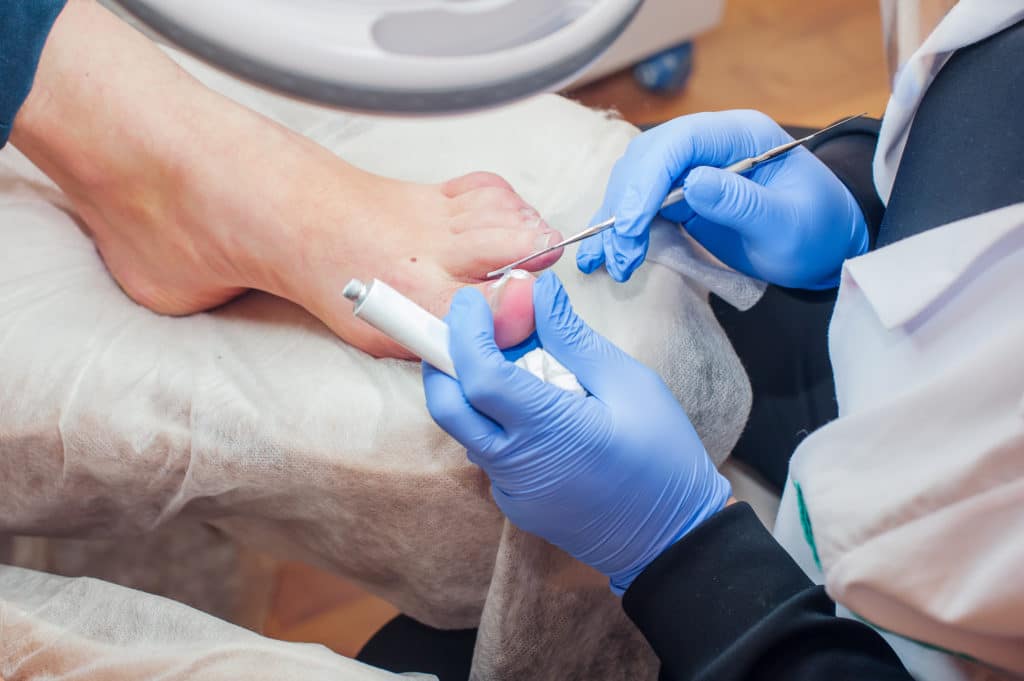Ingrown Toenails
An ingrown toenail is often a mild occurrence that may be treated successfully at home. That said, there are occasions when professional treatment is necessary or preferable, and Advanced Ankle & Foot is here to provide all patients with quick and comfortable care.
What is an Ingrown Toenail? What Causes One?
A toenail becomes ingrown when the edge or corner of the toenail grows into the surrounding flesh. This irritates the skin, typically leading to pain, redness, and swelling.
The big toe is by far the most likely to become ingrown, but the condition can happen on other toes as well. Ingrown toenails can also occur at just about any age, including with babies.
Ingrown toenails can occur for several different reasons.
- Tight or poorly fitting footwear. Shoes that compress or place too much force on the toes can contribute to ingrown toenail risk. This is one reason why ingrown toenails tend to occur in children, as their feet tend to quickly outgrow their footwear.
- Improper toenail trimming. Clipping toenails too short and too rounded can cause them to become ingrown as they grow back. A good practice is to cut each nail relatively straight with minimal curving at the corners and to leave a little portion of white at the end of each nail.
- Trauma. Toenails that have been damaged by trauma are more likely to become ingrown.
- It is a congenital condition. Some people are simply born with toenails that tend to grow in a more curved manner or have nails that are too large for their toes.
When Should You See a Professional for Ingrown Toenail Treatment?
You should never be hesitant to consult with us if you have concerns about an ingrown toenail, small or large. We’ll be happy to provide advice and treatment however necessary.
In general, however, there are certain situations where we highly recommend calling us about an ingrown toenail:
- You suspect an infection. (The toe is very painful, you see red streaks emanating from around the site of the ingrown edge, and/or pus is discharging from the area.)
- Your ingrown toenail is too painful to address on your own.
- You regularly get ingrown toenails despite making changes to reduce your risks (e.g. changing trimming habits, switching to more accommodating footwear).
- You have diabetes, poor circulation, or other conditions that increase your risk of complications from even minor injuries.
If none of the above factors apply to you, then attempting home treatment may be a viable option.
Home Treatment for Ingrown Toenails
If you wish to try home care, we recommend the following:
- Soak your foot in lukewarm water for 15-20 minutes, several times per day. This can help relieve some of the pain and swelling.
- After each soak, gently pat your foot dry, then apply antibiotic ointment to the toe.
- Loosely bandage the toe, using a new bandage after each soak.
- Keep to going safely barefoot, or wearing shoes that are open-toed or have roomy toe boxes, if possible.
Some sources may suggest placing a piece of dental floss or cotton beneath the nail. We do not recommend this, as foreign materials can become trapped beneath the nail and increase your infection risk. Also never cut a V-shaped notch into the nail, or otherwise, try to remove an ingrown toenail yourself. You can risk injury either with either method, which can also significantly increase your infection risk.
If your toe is not showing improvement within a day or two, give us a call.
Professional Treatment for Ingrown Toenails
We understand that many people might delay going to a professional for ingrown toenail treatment for fear of it being painful. However, we can assure you that seeing us is a much more comfortable experience than continuing with a painful ingrown toenail.
Let us evaluate your toenail to determine the best route of treatment. In some cases, we might lift the nail to provide the skin beneath a better opportunity to heal. In other cases, we may remove a tiny sliver or more of the nail itself during a minor, in-office procedure.
If a partial or full removal of the toenail is required, we will properly anesthetize the toe so you will not feel any discomfort. And once that numbness wears off, your toe should still feel substantially better than it did before.
For patients who frequently suffer from ingrown toenails regardless of attempts to reduce their risks, we might recommend treating the nail bed after removing the nail, preventing the nail from growing back. Although the nail will be gone, this will not cause any long-term damage to the toe or pose any significant risks to it.
Receive the Ingrown Toenail Treatment You Need
Whether you have concerns about an ingrown toenail you currently have or it’s just one in a steady line of recurring trouble, we can help you find a comfortable and lasting solution. We will always gladly examine any other skin or nail problems you may have as well.
Schedule an appointment at Advanced Ankle & Foot by calling (480) 962-4281 or by filling out our online contact form.

